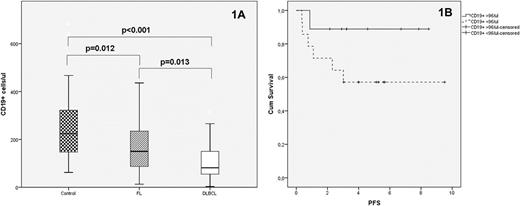Abstract
Introduction: Reduction of the lymphocyte to monocyte ratio (LMR) has an unfavorable impact on overall survival in Diffuse Large B Cell Lymphoma (DLBCL), and on treatment response in Follicular Lymphoma (FL). Abnormal LMR seems primarily due to a reduction in absolute value of lymphocytes. Based on these observations, we have prospectively investigated peripheral blood (PB) and Bone Marrow (BM) lymphocyte subpopulations in a series of previously untreated DLBCL and FL. Aim of the study was: i. to assess whether LMR alteration is linked to a distinct lymphocyte subset; ii. to correlate PB with BM cell subpopulations; iii. to compared DLBCL and FL with regards to PB and BM lymphocyte subpopulations. Methods: Overall, PB cells from 58 DLBCL and 27 FL at diagnosis were investigated; BM cell populations were analyzed in 77 DLBCL and 54 FL. None of the studied patients had BM involvement nor circulating lymphoma cells detectable by cytometry; in addition, none of the patients had been previously treated with immunosuppressive drugs. PB from 40 healthy subjects and BM samples from 69 subjects without primary BM dysfunctions were used as control. Multicolor flow cytometry (MFC) was used to evaluate percentages and absolute values of the following cell subsets: CD3+ T cell, CD3-CD56+ NK cells, CD19+CD20+ B cells. Among B cells, t he analysis included transitional (CD38+high/CD24+high/IgD+/CD27-), naive (CD38+/CD24+/IgD+/CD27-), memory IgD+ (CD38-/+CD24+/IgD+/CD27+), and memory IgD- (CD38-/CD24+high/IgD-/CD27+) subsets; B cell precursors were investigated as CD19+CD20-CD10+ and mature B cells as CD19+CD20+CD10-. Results: A significant reduction in median absolute lymphocyte count was seen in PB from lymphoma patients (median: 1,526/µL) compared to controls (median: 2,195/ µL). Moreover, absolute lymphocytes were more markedly reduced in DLBCL (median: 1,386 /µL) compared to FL (median: 1883/µl) (p<0.001). This resulted in a significantly lower median PB-LMR in DLBCL (median LMR: 3) compared to FL patients (median LMR: 5) (p=0.001). Among PB cell subpopulations, a marked reduction in circulating B cells was observed in lymphoma patients (median 96/µL) compared to controls (median 224/µL). Again, loss of circulating B-cells was more markedly pronounced in DLBCL (median: 81.5 cell/µL) compared to FL (median: 150 cell/µL) (p=0.013). Differences in circulating B-cells among DLBCL, FL and controls are shown in Figure 1A. At BM analysis, a reduction of B cell precursor (CD19+/CD20-/CD10+) could be documented only in DLBCL. A reduction in circulating T-lymphocytes in lymphoma patients compared to controls was detected as well, although at a lower extent compared to B-cells. No significant abnormalities in the amount of circulating NK-cells was seen in both DLBCL and FL patients. When these data were matched with treatment outcome, the reduction of circulating B cells proved to be associated with an unfavorable outcome in younger patients with DLBCL. Indeed, among DLBCL patients aged < 60 yrs, a poorer progression free survival was seen in those having less than 96 B-cells/µL compared to those with PB B-cells equal or above 96 B-cells/µl (Figure 1B). Conclusions: The study indicates that circulating B lymphocytes are significantly reduced in both DLBCL and FL compared to age-matched healthy controls; however, their loss is much more pronounced in DLBCL compared to FL. Indeed, abnormalities in B-cell progenitors are present in BM from DLCBL but not from FL. In addition, B-cell reduction may have an unfavorable impact in the long-term outcome of DLBCL, at least in younger patients. Lastly, both B and T-cell subsets are decreased in DLBCL and FL whereas circulating NK subset does not seem to be affected.
No relevant conflicts of interest to declare.
Author notes
Asterisk with author names denotes non-ASH members.


This feature is available to Subscribers Only
Sign In or Create an Account Close Modal